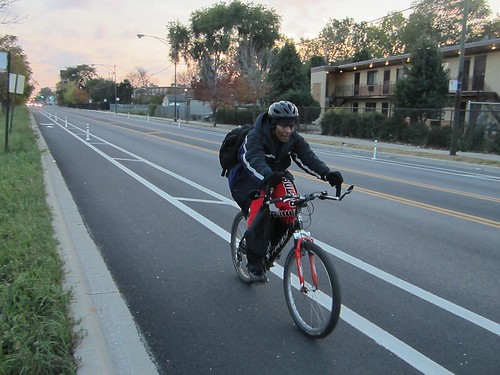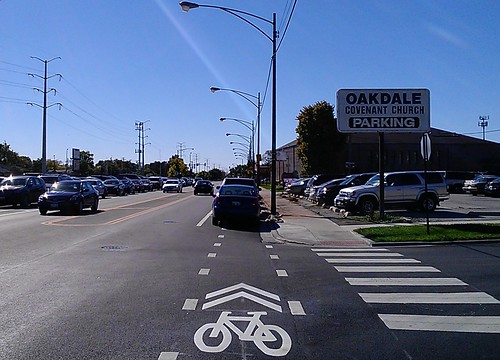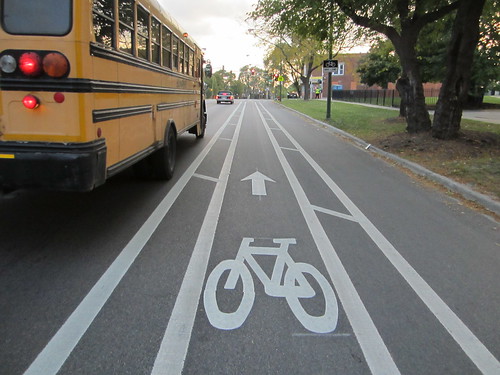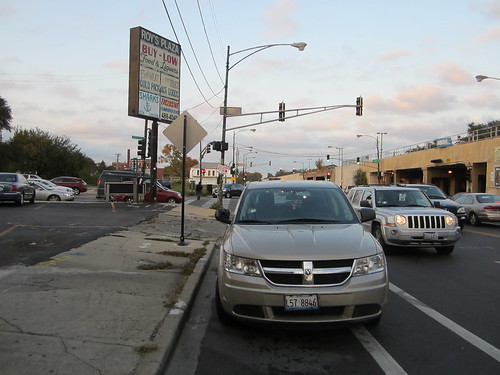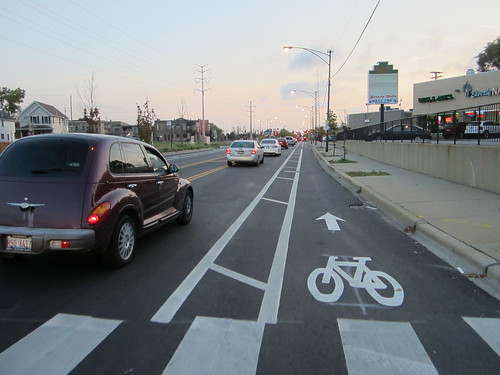Our extended New Bikeways Week wraps up today with a look at the 2.65-mile stretch of new protected and buffered lanes that the Chicago Department of Transportation recently installed on Vincennes Avenue from 84th Street to 103rd Street. Vincennes, a diagonal road leading downtown from the Far Southwest Side, is designated as a bike-priority Spoke Route in the city’s Streets for Cycling 2020 Plan. In general, the agency has installed buffered lanes with curbside car parking on the west side of Vincennes, and curbside bike lanes, with striped buffers and flexible posts to discourage motorists from driving in them, on the east side.
While conventional bike lanes previously existed on this stretch, CDOT removed them to increase motor vehicle capacity on the street during the Dan Ryan Expressway reconstruction from 2006 to 2008. In addition to making the street more bike-friendly, one of the main incentives for reinstalling and upgrading the lanes this year was to narrow the travel lanes and calm traffic on a street where speeding was a major issue, according to project manager Mike Amsden.
View Untitled in a larger map
The new bike lanes run from 84th to 103rd.
There were 981 reported crashes, with 25 serious injuries and three fatalities, on this street between 2006 and 2010, Amsden said. Speed measurements taken last year at 92nd and Vincennes found that 63 percent of southbound motorists and 86 percent of northbound drivers were speeding. Sixteen percent of the southbound motorists were traveling above 40 mph, and 41 percent of the northbound ones were. “That’s incredibly fast and incredibly dangerous,” Amsden told me.
Streetsblog Chicago contributor and Beverly resident Anne Alt has ridden the new Vincennes lanes several times in both directions during rush hours, as well as on weekends, and has viewed it from aboard Metra’s Rock Island Line, which parallels most of the route. “Driver behavior has been 1,000 percent better on most of this segment since restriping,” she reports. “Even when there are no cyclists present, most drivers are respecting the lanes.”
One exception has been just north of 95th Street by Oakdale Covenant Church during Sunday services, when the southbound lane is full of parked cars, Alt said. “Traffic during this time is usually light, so the lane blockage does not create a significant hazard. Considering all the pushback with the West Side churches [against protected bike lanes on Independence Boulevard], and the fact that this is only one church for a few hours out of the week, I'm not inclined to fight it.”
I took a spin on the new lanes myself yesterday during the evening rush. The northern terminus of the lanes is in Gresham, just south of 83rd Street, which has conventional bike lanes east of Vincennes. Here the Vincennes lanes are buffered on each side of the street with lightly used curbside parking. The pavement doesn’t seem to be brand new, but it’s in good condition.
The street makes a bend at 87th Street, by a small shopping plaza. By this point the asphalt is freshly laid and silky smooth. Although the plaza's parking lot wasn’t full, a car was parked in the southbound bike lane. At 89th Street, the northbound bike lanes become curbside with flexible posts. The posts are spaced fairly far apart from each other, but they send a message to motorists to stay out of the lane, and make it too narrow to drive or park in.
The new configuration does seem to be moderating car speeds. Drivers were moving at a good clip, but I didn’t see much egregious speeding, except for one or two occasions when a motorist used the unprotected southbound bike lane as a passing lane. South of 95th Street in Longwood Manor, the protected lane is replaced by sharrows to make room for an extra turning lane onto busy 95th.
At 97th Street, the southbound lanes become curbside and flexible post-protected, and at 99th Street the northbound protected lanes briefly drop out again to make room for a second car lane. The southbound lanes revert to buffered lanes with parking at 99th Place, and the northbound lanes change from protected to buffered at 101st Place.
The lanes end at 103rd Street, at the border of Beverly and Washington Heights, where there’s a bit of strip-mall retail and a Metra stop. While there aren’t any other existing bike lanes anywhere near this southern terminus, a bit further southeast at 105th and Throop Street cyclists can pick up the southern leg of the Major Taylor Trail.
At this point I turned around and pedaled back northeast in the post-protected lane towards the 95th Street Red Line station. Rolling in a long stretch of the protected lane for the first time, I felt nicely separated from the moderately swift northbound car traffic. I assume that less experienced bike riders will enjoy this feeling of protection even more, so it seems like the new lanes are a major improvement to Vincennes.
It's been fun checking out many miles of new bikeways this past week or so. While it would be great to see a higher ratio of protected lanes to buffered lanes in the future, all of the bikeways I rode seemed well-designed and executed, and there were a few interesting new street treatments. The large number of lanes installed on velvety blacktop is especially appreciated. CDOT deserves kudos for all their hard work expanding Chicago's bike network this year, and I look forward to seeing whether they can meet their goal of reaching 100 miles of protected and buffered lanes by next spring.
